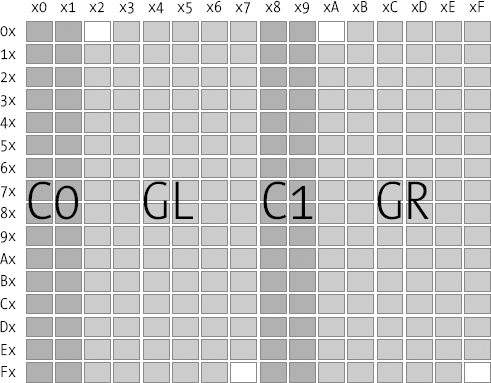1.4. ISO 2022
In the early 1970s, the industry was well aware of the fact that the "localized" versions of ASCII were an impediment. People had to use multiple encodings that were really quite different, and sooner or later they had to switch from one encoding to another in the middle of a document or a transmission. But how to indicate this change of encoding?
Figure 1-2. The manner in which ISO 2022 subdivides the 8-bit table.

It was for this reason that the ISO 2022 standard emerged, in 1973. Its latest revision dates to 1994 [193]. It is not an encoding but a definition of a certain number of escape sequences that make it possible to use as many as four distinct encodings within the same set of data.
ISO 2022 starts from the principle that the 256 squares in a table of 8 bits are distributed among four zones, which can be seen in Figure 1-2. Zones C0 and C1 are reserved for control characters, and zones GL ("L" for "left") and GR ("R" for "right") are reserved for what today are known as alphanumeric characters (and what at the time bore the oxymoronic name "graphic characters", whence the 'G').
Thus we have up to four distinct encodings at our disposal. Let us call them G0, G1, G2, G3. These encodings may be of any of four types:
Encodings with 94 positions: 6 columns with 16 positions each, minus the two excluded positions, namely the first and the last.
Encodings with 96 ...
Get Fonts & Encodings now with the O’Reilly learning platform.
O’Reilly members experience books, live events, courses curated by job role, and more from O’Reilly and nearly 200 top publishers.

